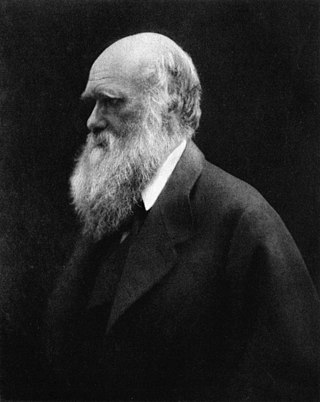
Darwinism is a theory of biological evolution developed by the English naturalist Charles Darwin (1809–1882) and others, stating that all species of organisms arise and develop through the natural selection of small, inherited variations that increase the individual's ability to compete, survive, and reproduce. Also called Darwinian theory, it originally included the broad concepts of transmutation of species or of evolution which gained general scientific acceptance after Darwin published On the Origin of Species in 1859, including concepts which predated Darwin's theories. English biologist Thomas Henry Huxley coined the term Darwinism in April 1860.
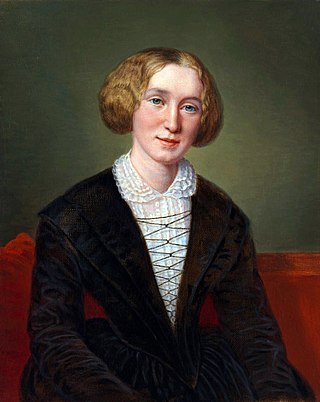
Mary Ann Evans, known by her pen name George Eliot, was an English novelist, poet, journalist, translator, and one of the leading writers of the Victorian era. She wrote seven novels: Adam Bede (1859), The Mill on the Floss (1860), Silas Marner (1861), Romola (1862–63), Felix Holt, the Radical (1866), Middlemarch (1871–72) and Daniel Deronda (1876). Like Charles Dickens and Thomas Hardy, she emerged from provincial England; most of her works are set there. Her works are known for their realism, psychological insight, sense of place and detailed depiction of the countryside.
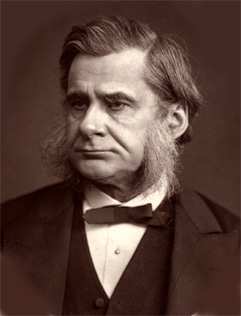
Thomas Henry Huxley was an English biologist and anthropologist specialising in comparative anatomy. He has become known as "Darwin's Bulldog" for his advocacy of Charles Darwin's theory of evolution.

Charles Kingsley was a broad church priest of the Church of England, a university professor, social reformer, historian, novelist and poet. He is particularly associated with Christian socialism, the working men's college, and forming labour cooperatives, which failed, but encouraged later working reforms. He was a friend and correspondent of Charles Darwin.

Samuel Wilberforce, FRS was an English bishop in the Church of England, and the third son of William Wilberforce. Known as "Soapy Sam", Wilberforce was one of the greatest public speakers of his day. He is now best remembered for his opposition to Charles Darwin's theory of evolution at a debate in 1860.

St. George Jackson Mivart was an English biologist. He is famous for starting as an ardent believer in natural selection who later became one of its fiercest critics. Mivart attempted to reconcile Darwin's theory of evolution with the beliefs of the Catholic Church, and finished by being condemned by both.

John TyndallFRS (; 2 August 1820 – 4 December 1893) was a prominent 19th-century Irish physicist. His scientific fame arose in the 1850s from his study of diamagnetism. Later he made discoveries in the realms of infrared radiation and the physical properties of air, proving the connection between atmospheric CO2 and what is now known as the greenhouse effect in 1859.
The Anthropological Society of London (ASL) was a short-lived organisation of the 1860s whose founders aimed to furnish scientific evidence for white supremacy which they construed in terms of polygenism. It was founded in 1863 by Richard Francis Burton and James Hunt. Hunt had previously been the secretary of the Ethnological Society of London, which was founded in 1843. When he founded the breakaway ASL, Hunt claimed that society had "the object of promoting the study of Anthropology in a strictly scientific manner". Nevertheless he reminded his audience that, whatever evidence might be uncovered, "we still know that the Races of Europe now have much in their mental and moral nature which the races of Africa have not got." The ASL only lasted 8 years: following Hunt's death in 1869 it was absorbed into the Royal Anthropological Institute of Great Britain and Ireland.
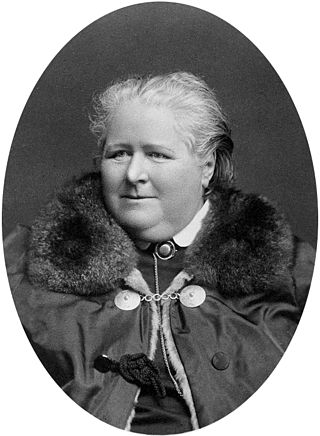
Frances Power Cobbe was an Anglo-Irish writer, philosopher, religious thinker, social reformer, anti-vivisection activist and leading women's suffrage campaigner. She founded a number of animal advocacy groups, including the National Anti-Vivisection Society (NAVS) in 1875 and the British Union for the Abolition of Vivisection (BUAV) in 1898, and was a member of the executive council of the London National Society for Women's Suffrage.
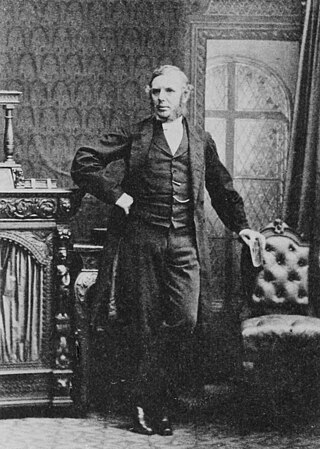
Henry Baker Tristram FRS was an English clergyman, Bible scholar, traveller and ornithologist. As a parson-naturalist he was an early supporter of Darwinism, attempting to reconcile evolution and creation.

Sir Edwin Ray Lankester was a British zoologist.

The X Club was a dining club of nine men who supported the theories of natural selection and academic liberalism in late 19th-century England. Thomas Henry Huxley was the initiator; he called the first meeting for 3 November 1864. The club met in London once a month—except in July, August and September—from November 1864 until March 1893, and its members are believed to have wielded much influence over scientific thought. The members of the club were George Busk, Edward Frankland, Thomas Archer Hirst, Joseph Dalton Hooker, Thomas Henry Huxley, John Lubbock, Herbert Spencer, William Spottiswoode, and John Tyndall, united by a "devotion to science, pure and free, untrammelled by religious dogmas."

Edward Clodd was an English banker, writer and anthropologist. He had a great variety of literary and scientific friends, who periodically met at Whitsunday gatherings at his home at Aldeburgh in Suffolk.

The Cornhill Magazine (1860–1975) was a monthly Victorian magazine and literary journal named after the street address of the founding publisher Smith, Elder & Co. at 65 Cornhill in London. In the 1860s, under the editorship of William Makepeace Thackeray, the paper's large circulation peaked around 110,000. Due to emerging competitors, circulation fell to 20,000 by 1870. The following year, Leslie Stephen took over as editor. When Stephen left in 1882, circulation had further fallen to 12,000. The Cornhill was purchased by John Murray in 1912, and continued to publish issues until 1975.

The 1860 Oxford evolution debate took place at the Oxford University Museum in Oxford, England, on 30 June 1860, seven months after the publication of Charles Darwin's On the Origin of Species. Several prominent British scientists and philosophers participated, including Thomas Henry Huxley, Bishop Samuel Wilberforce, Benjamin Brodie, Joseph Dalton Hooker and Robert FitzRoy.

Sir Richard Owen was an English biologist, comparative anatomist and paleontologist. Owen is generally considered to have been an outstanding naturalist with a remarkable gift for interpreting fossils.

Bernard Vise Lightman, FRSC is a Canadian historian, and professor of humanities and science and technology studies at York University, in Toronto, Ontario, Canada. He specializes in the relationship between Victorian science and unbelief, the role of women in science, and the popularization of science.

Richard St John Tyrwhitt (1827–1895) was an English cleric and academic, known as a writer on art.
The London Dialectical Society was a British professional association that formed in 1867 to encourage debate "of all questions without reserve, but especially those comprised in the domain of ethics, metaphysics, and theology". It is best known for its investigation into and report on the claims of spiritualism.
Thomas Bendyshe (1827–1886) was an English barrister and academic, known as a magazine proprietor and translator.